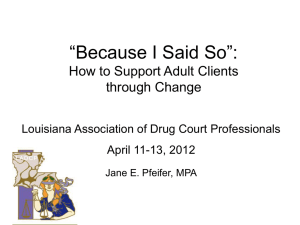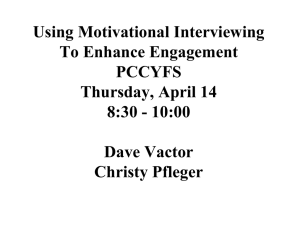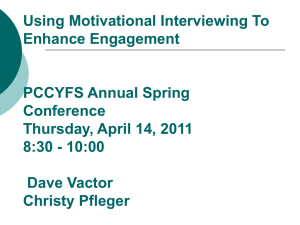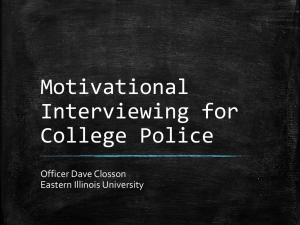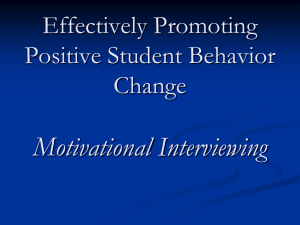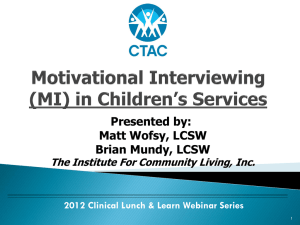Motivational Interviewing – An Overview
advertisement
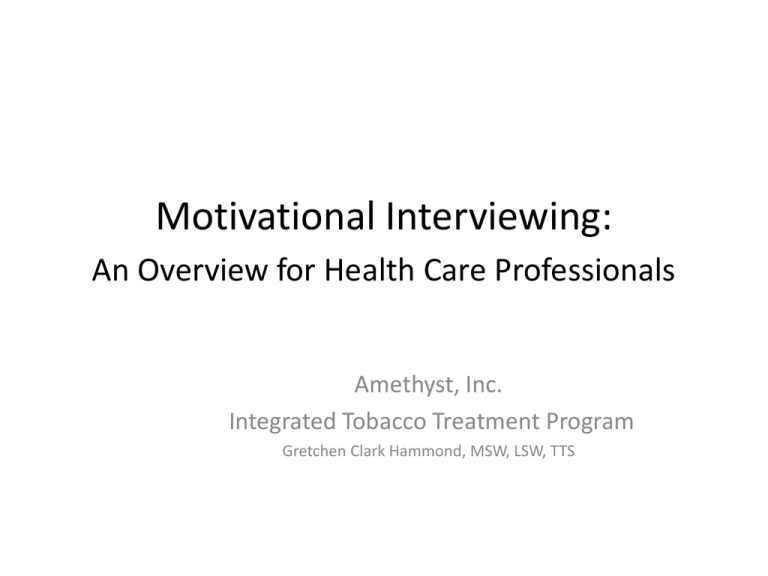
Motivational Interviewing: An Overview for Health Care Professionals Amethyst, Inc. Integrated Tobacco Treatment Program Gretchen Clark Hammond, MSW, LSW, TTS Our Objectives for Today Upon completion of this workshop, you will: • Be familiar with the basic components and philosophy of Motivational Interviewing (MI). • Be familiar with the Transtheoretical Model (TTM) and its application to MI. • Improve their understanding of the application of MI to various populations and health concerns. • Feel like you could put some of these basic concepts to use in your everyday practice! Motivational Interviewing: Context • Motivational Interviewing (MI) is an approach that works with resistance from a perspective of joining with the client (The Dance) • Think of MI as more of a method of communication versus a set of techniques • Compliments the Stages of Change Model (Prochaska & DiClemente) • MI believes that the resolution of ambivalence can lead to progression through the stage of change. MI is used in many settings • • • • • Addiction Treatment Medical Offices Public Health Criminal Justice Private Practice/Therapy/Counseling MI is used in many settings • It is useful in many settings because it addresses CHANGE, which affects many of life’s situations: – Changing behavior – Changing actions – Changing thoughts – Changing emotions Motivation • Motivation is an interesting concept, vastly misunderstood by most of us. Motivation Motivation is FUNDAMENTAL to change. Motivation is comprised of three elements: • Importance (for the change): willingness, desire or perceived importance • Confidence (about being able): self-efficacy • Readiness (to make the change): priorities These three elements are not the same and impact motivation differently. Motivation • Importance: My Head • Confidence: My Heart • Readiness: My Gut • Is the fire under me lit, and is it hot enough to burn? Motivation and Ambivalence • Ambivalence refers to having mixed or conflicted feelings (Pro vs. Con) • “I really enjoy smoking, but I know it’s bad for my health” • Ambivalence is a normal part of any change process and is usually connected to fears and concerns • Motivational Interviewing attempts to help the client resolve the ambivalence towards change. Facilitating Change • Change may occur in a stage-like process: • The Transtheoretical Model/Stages of Change (Prochaska and DiClemente) – – – – – Precontemplation Contemplation Preparation Action Maintenance And, of course, there is RELAPSE, which is also a stage. Motivational Interviewing (MI) : “The Dance” • Three key principles in utilizing Motivational Interviewing – Collaboration – NOT confrontation – Evocation – NOT education/advice – Autonomy – NOT authority Motivational Interviewing Support Self-efficacy: • Convey faith in the clients’ ability to change • Client chooses goals • Point out and support client’s strengths and accomplishments To Summarize: • Motivation is complex and often misunderstood • We understand that ambivalence is normal and often what holds a person back • We can work with resistance • We recognize the autonomy of the individual • We realize that we must connect with a person in order to understand how to help them with a change process. Motivational Interviewing: The Components • Open-ended question/open-ended statement • Affirm their feelings/thoughts through the use of reflection • Reflection of feeling; reflection of actual statements • Summarize what was said while posing the next step back to the individual. MI: The Components • We use these four components interchangeably to address the particulars of ambivalence, which live in three zones: – Importance – Confidence – Readiness Our goal is to ENGAGE with the patient so that we can begin moving forward almost immediately. MI: The Components Opening the Conversation • Ask an open-ended question • Affirm the client’s feeling • Recognize their ambivalence, resistance, fears, etc through the use of reflection. (No challenges to what they say) Motivational Interviewing: The Components Affirming and Reflecting – Helps check in with the client; saves you from a false assumption • Repeating – repeat back something the client has said • Reflection of feeling – paraphrase the client’s emotions • Rephrasing – stays close to what was said, but slightly rephrases • Paraphrasing – infer meaning into what was said and reflect back in new words MI: The Components Opening the Conversation HCP (Health Care Professional): Please tell me about your current tobacco use. Patient: I know I need to quit smoking, but I don’t want to talk about it. I’m not ready to quit. HCP: It sounds like quitting smoking is not a high priority for you right now. Patient: Right. I have too many things going on. HCP: So, in your list of priorities for things you need to address, where would you place this one? Patient: Well, closer to the bottom than the top. HCP: Help me understand what’s at the top of that list. MI: The Components • One often assumes that asking open-ended questions is easy. • One also assumes that providing an affirming, non-confrontational statement is easy. • Both of these assumptions are false. Practice makes Almost-Perfect • Opening a close-ended question • Using reflective statements • Please see your handouts. MI: The Components What are we driving at here with this approach? We want to get at some change talk: Helping people make their own argument for change. Purpose: to elicit the client’s own reasons for and advantages of change. • Desire • Ability • Reason • Need Motivational Interviewing: The Components Change Talk Essence of change talk: Get the client to make his or her own argument for change! - Ownership and meaning come from this process Remember: this is not about your reasons – they have to make their own argument in order for this change to work. You will not get at this process if you are not engaged with the patient. But, Gretchen… …I don’t have time to have a long conversation with the patient. …I am not prepared for them to “open up” and tell me lots of things that I don’t want to hear. …this sounds like therapy and I don’t do therapy. Well, Friends… …the time we have with the patient is precious and we certainly don’t have time to smack up against resistance over and again. …in a time crunch I want to be INCREDIBLY effective and efficient so I need to get to the heart of the matter right quick! …and, last I checked, my job was to assist people in making some kind of major change, so I better figure out how to get that done, and it may involve a minute of conversation. Well, Friends… …if the patient begins to tell you too much, you’ve got a way to get out of the situation: - “Thank you for sharing with me all the things going on in your life. That must be hard for one person. I’m here to help you with X. I can provide you with a referral to assist you with Y, Z, A, and B.” Use this moment to define your role and to let the person know the kind of help you can provide. MI: Additional Tools Assessing Importance and Confidence • Suggested technique: Scaling – Ask questions based on a scale of 0 to 10, with 0 being not important at all, to 10 being extremely important – Explore the reasons behind the selection of each number with them (i.e. why are you at a 4 and not a 3?) – Ask what would move them higher on the scale (i.e. what would help you move this to a 5 or a 6?) – Ask how you could be helpful in moving from a 4 to a 5 or 6. What are we looking for with this tool? • Scaling allows us to see where we need to focus our energy! – If importance is high and confidence is low, then I need to boost confidence. – How do I do that? – You look for moments of ambivalence! (Let’s look at the previous slides for these moments) Resolving Ambivalence • We can resolve ambivalence in several ways: – – – – Non-threatening education Myth busting Exploration Explanation We use open-ended questions to understand the source of the ambivalence, then we reflect and summarize in order to move forward. Note to Self: • Helping people change is a process and they might not get it all done in one session. • We are progressing towards change and looking for change talk to occur. • Sometimes folks will need to sit with their ambivalence and awareness for a moment. MI: Putting it to Use Explore Past Efforts • Recognize the past as a valuable piece of information • Explore what worked, and what didn’t • Help them plan a more successful attempt for change MI: Additional Tools • The Decisional BalanceGood things about smoking Not so good things about quitting Not so good things about smoking Good things about quitting What are we trying to do with this tool? Develop Discrepancy: • Discrepancy between current behavior and future goals – Obtain client goals – Emphasize discrepancy between behavior and goals What are we trying to do with this tool? • Take a look at ambivalence! • The decisional balance goes beyond a pros and cons list What makes it so hard to change? • Any addiction or disease process has three major pieces: – Physical – Emotional – Social/Behavioral All three pieces must be addressed if we are going to be effective with our patients! Motivational Interviewing: Putting it to Use Food for thought: Remember, most people don’t want to destroy their health or not listen to medical advice. They feel stuck and often have deep emotional connections to their health problem. When we ask people to make lifestyle changes they often feel overwhelmed. These are emotional and social reasons that hold a person back. Resources for learning more about Motivational Interviewing: • Eberman, K.M., Patten, C.A., & Dale, L.C. (1998). Counseling patients to quit smoking: What to say, when to say it, and how to use time to your advantage. Postgraduate Medicine, 104 (6), 89-94. • Miller W.R., & Rollnick, S. (2003). Motivational Interviewing: Preparing People for Change. (2nd ed.). The Guilford Press: New York. • Rollnick, S., Mason, P., & Butler, C. (1999). Health Behavior Change: A Guide for Practitioners. Churchill Livingston: New York.
